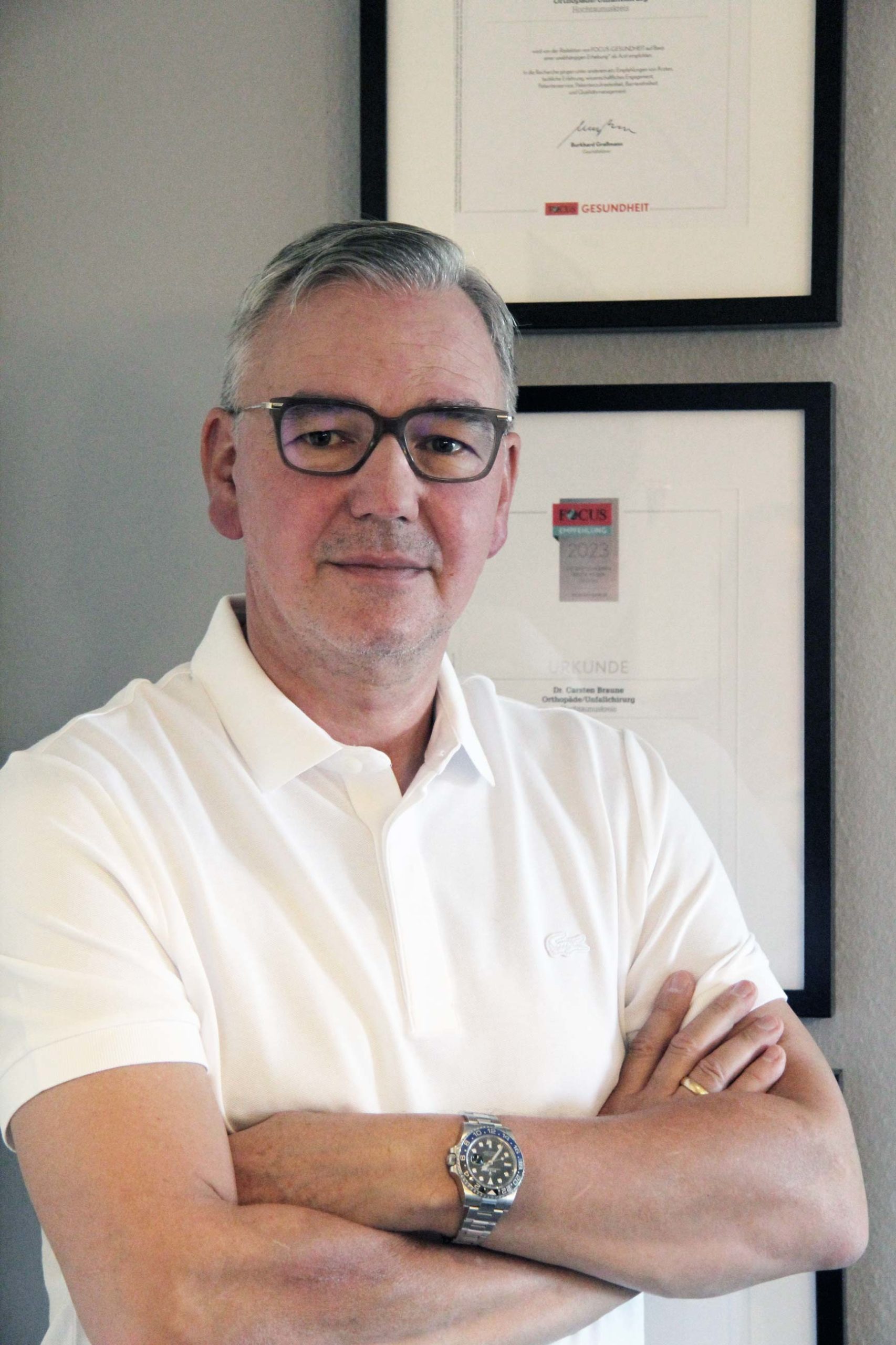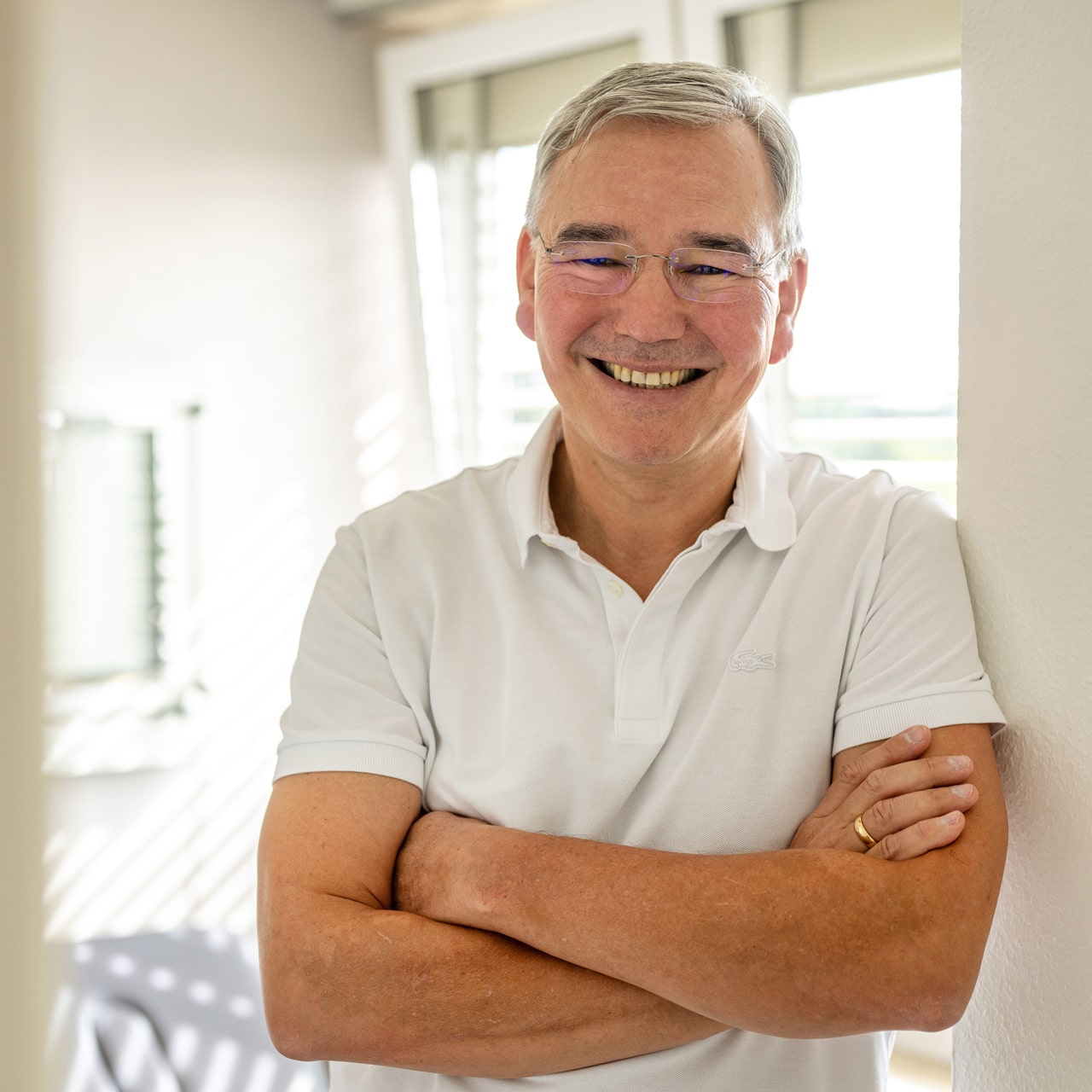Gonarthrosis
When walking becomes a burden
The knee joint is the largest joint in the human body and fulfils crucial functions for normal mobility in everyday life as well as in sports. If this important joint is affected by a disease and its function is thus disturbed, this has drastic consequences for those affected. The diagnosis is quite common in old age, but osteoarthritis in the knee joint can also occur at a younger age due to incorrect stress.
In this article, you will learn what exactly happens with this condition, what therapies are available to alleviate the symptoms and what you should keep in mind during the course of treatment. We will also inform you about what it means if you have been diagnosed with medial or varus gonarthrosis.
Thanks to state-of-the-art diagnostics, Dr. Braune recommends individual treatment strategies to his patients and , as an experienced orthopaedic surgeon, is able to perform surgical procedures.
Definition
What is gonarthrosis?
The term gonarthrosis is mainly used in medical terminology and describes the circumstance when arthrosis occurs in the knee joint. Gonarthrosis and knee arthrosis can thus be used synonymously. In general, one speaks of arthrosis when a joint is characterised by signs of wear. This results in the breakdown of cartilage tissue, which normally ensures that the bones of the joint can interact well with each other.
The difference between osteoarthritis and arthritis
In common usage, the terms arthrosis and arthritis are often equated. However, these are two different diseases. With arthritis, there is an acute or chronic inflammation in a joint, which does not necessarily occur with arthrosis. However, a combination of both forms of the disease often occurs as the disease progresses, especially if one disease is left untreated.
Contact us for clarification
Therapy
How is gonarthrosis diagnosed?
The basis for any diagnosis is usually a discussion between the doctor and the person being treated, which is also called an anamnesis discussion. The symptoms that are described by the person concerned during this discussion already provide decisive indications as to whether the complaints are actually knee osteoarthritis.
This discussion is followed by a physical examination. Here, the person treating the patient can already determine whether there is a malposition in the knee joint that could be the cause of the gonarthrosis that has developed. In this context, different forms of arthrosis are distinguished.
Depending on the axial position of the knee joint, medial or lateral gonarthrosis can occur. In medial gonarthrosis, also known as varus gonarthrosis, there is an O-B setting, which leads to the medial (i.e. towards the centre of the body) parts of the knee joint being loaded and thus to a degeneration of the cartilage tissue due to overloading. In contrast, an X-B adjustment leads to lateral knee arthrosis. This form of arthrosis is also called valgus-gonarthrosis.
Physical examinations and imaging techniques for an accurate diagnosis of gonarthrosis
In the course of the physical examination, it can also be determined whether a cyst (Baker's cyst) has already formed in the area of the popliteal fossa or whether a joint effusion has occurred in which the knee is swollen and overheated.
In the very advanced stage, the thigh muscles of both legs are compared with each other. If the symptoms have existed for a long time, the thigh musculature of the affected leg will be reduced as a result of the protective posture or the reduced load.
In order to make a definitive diagnosis with an assessment of severity or to confirm a suspected diagnosis, an imaging procedure is usually also used. It is also possible to distinguish precisely whether the diagnosis is medial (varus gonarthrosis) or lateral (valgus gonarthrosis). X-rays are the best way to show the bony structures involved in the knee joint. If the degeneration of soft tissues is to be assessed, an MRI is used.
Have your knee examined
Classification of arthrosis by degrees of severity
To classify the existing complaints, the findings are evaluated with the help of various scales. For example, the Kellgren-Lawrence score or the Outerbridge classification are used. Both of these scales define four different degrees of severity of arthrosis, which are then used to determine the corresponding treatment options.
- In the case of the Kellgren-Lawrence score, severity 0 indicates normal findings.
- In severity 1, gonarthrosis is suspected, but has not yet been clearly confirmed.
- Severity 2 describes minimal arthrosis where it could be determined that small bone outgrowths (so-called osteophytes) have occurred, which are typical of arthritic joints.
- These osteophytes are more prevalent in severity 3 and a narrower joint space can be detected in the knee joint due to the degenerated cartilage tissue.
- Finally, at severity 4, the conditions already described worsen and at the same time deformities, i.e. deformities, of the bones involved in the formation of the joint can be detected.
The Outerbridge classification is mainly used to describe the condition of the joint cartilage. This classification is mainly done during a joint endoscopy or arthroscopy.
How can gonarthrosis be treated?
The good news is that there are some approaches to treating knee osteoarthritis. First and foremost, conservative methods are used with the aim of relieving pain, promoting mobility and avoiding surgery if possible.
Medicines called non-steroidal anti-inflammatory drugs are used to relieve acute pain. Examples of these are aspirin or diclofenac. These are either applied to the affected joint in the form of ointments or taken in tablet form if the desired effect is not achieved by the ointments. In addition, orthopaedic aids, for example suitable shoe insoles, should be used in the case of gonarthrosis that is due to a malposition of the legs, in order to better distribute the weight acting on the knee joint. Practising suitable sports such as swimming or cycling lead to an appropriate load on the knee joint, which is associated with a corresponding increase in blood circulation. In this way, the affected tissue can recover better and, if necessary, build up some cartilage substance again.
Hyaluronic acid injections as a treatment method
Another treatment method with good results is the injection of hyaluronic acid into the affected joint. Hyaluronic acid is a naturally occurring substance in the body that belongs to the glycosaminoglycans. Hyaluronic acid, also called hyaluronate, has the property of binding water well and therefore fulfils the function of a natural "lubricant" for the joints in the body. This form of treatment is particularly suitable when the cartilage within the joint has not yet completely degenerated. A minimum amount of intact cartilage tissue is necessary so that the hyaluronic acid has a surface on which it can spread well and on which it can perform its "lubricant" function. At the same time, hyaluronic acid injection treatment slows down the progression of cartilage destruction.
In addition to the treatment methods already mentioned, physical measures such as heat or cold therapy can be used. Weight reduction can also help to alleviate the symptoms of gonarthrosis, as the joint can be spared in this way.
If the therapeutic approaches listed do not bring the desired success, surgical treatment remains as the last measure. However, this is not necessary in most cases.
Let us advise you
Opportunities & Risks
What are the chances and risks of treating gonarthrosis?
Basically, it must be said that knee osteoarthritis is a chronic disease that progresses slowly. However, the course can be slowed down by appropriate treatment. The decisive factor here is that treatment is initiated at an early stage if possible.
As with all treatments for diseases, the benefits and risks must always be carefully balanced. When administering medication, care must be taken to ensure that there is no allergy. However, the dose administered must also not fall below a certain limit, otherwise the desired effect will not be achieved.
Since hyaluronic acid is a substance produced naturally in the body, there is no risk of an allergic reaction when it is injected into the affected joint. However, care must be taken to work in a sterile manner and to avoid inflammation of the knee joint due to spreading germs. Due to the precision of the injection with a relatively small needle, this risk is rather low.
An additional positive factor is that the injection of hyaluronic acid usually produces pain relief from the first treatment, which lasts for several months, in some cases even up to a period of one year.
In general, it can be said that the course of knee osteoarthritis can often be controlled well with conservative treatment methods. The use of surgical treatment methods is on the one hand associated with a higher expenditure of time and money for patients and on the other hand there is always the risk of an infection of the surgical wound or an unfavourable course of the operation.
Conservative therapies such as the administration of medication or the injection of hyaluronic acid into the diseased joint therefore usually have the better risk-reward ratio.
Make an appointment online now
Preparation & Follow-up
What do I have to consider around the treatment of my gonarthrosis?
Before starting therapy for gonarthrosis, a proper diagnosis should be made in order to initiate adequate treatment. Basically, you should know whether you have an allergy to a pain medication that is prescribed for you. However, as mentioned above, this preparatory measure is not necessary for treatment with hyaluronic acid. Before an injection treatment with hyaluronic acid for knee osteoarthritis, however, you should make sure that the knee to be treated remains as clean as possible and that there is no inflammation or wound in the area to be injected. If this is the case, there is a higher risk of germs spreading to the inside of the knee.
If you decide to have a treatment with hyaluronic acid, please ask your health insurance company beforehand whether the costs are covered. Generally, statutory health insurance companies do not pay for this type of treatment. The average cost of hyaluronic acid is about 400€, assuming three to five treatments. A single treatment is completed within 10 minutes and the number of treatments depends on the course of treatment.
Make an appointment online now



